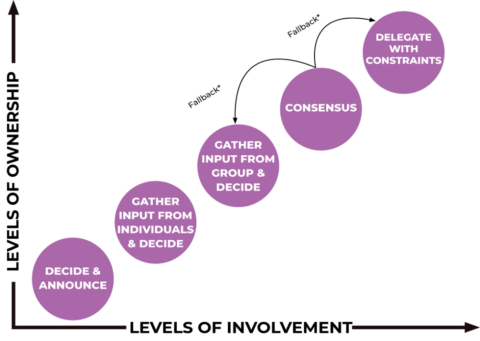There is no one right way to involve people in decision making. You’ll want to think about whom to involve and the most appropriate levels of involvement based on how directly they will be affected by the decision or surrounding issues, how much the decision presents an opportunity to share power and dismantle oppression, the importance of the issue, the group’s capacity for consensus building, the ability to share enough information to enable meaningful participation, and available time and resources.
How to Involve People: Levels of Involvement in Decision Making
For a given decision, you’ll want to choose the level(s) of involvement for different individuals and groups.
DECIDE AND ANNOUNCE
The Facilitative Leader makes a decision with little or no input then announces the decision to those who will be affected by or must carry out the decision.
GATHER INPUT FROM INDIVIDUALS AND DECIDE
The Facilitative Leader asks selected individuals for input (ideas, suggestions, information). The leader makes a decision after gathering input from the individuals.
GATHER INPUT FROM GROUP & DECIDE
The Facilitative Leader asks the group members to share their ideas. The leader makes a decision after hearing from the group.
CONSENSUS
A consensus decision is one that every member of the team is willing to support and help implement. All key stakeholders have had an opportunity to give their opinion and to understand the implications of various options. All members, including the leader, have the same formal power to support or block proposals. The group should agree on a fallback option for making a decision if consensus cannot be reached. The fallback might be to a super-majority, to the leader, to a person with relevant expertise or skills, or to a subset of leaders (e.g., BIPOC leaders). If consensus on the criteria is not reached, the fallback option is invoked. If the fallback is to the leader or other individual or group, they will make the final decision, taking the group’s discussion into account.
DELEGATE DECISION WITH CONSTRAINTS
The Facilitative Leader defines the decision that needs to be made in the form of a question or questions, clarifies the constraints on the decision (e.g., budget, timeframe, quality requirements), and delegates the decision to others. The leader does not alter the decision as long as it follows the constraints. A fallback option should be identified in the event the group cannot make the decisions within the constraints.
Who to Involve: Your Care-Holders
A care-holder (often known as a stakeholder) is any person or group of people who has a share, interest, or involvement, including those who:
- Are likely to be impacted by the outcome of the decision
- Are typically unheard, excluded, or marginalized
- Function as a connector in or across the organization(s) / sector(s) / field(s)
- Are in a position to implement the decision
- Are in a position to prevent the decision from being implemented
- Have relevant information or expertise, including lived experience and self-directed study
- Have informal influence without authority
- Are responsible for the final decision
- Are Indigenous to the land you are on
Avoid tokenization by ensuring critical mass (no individual represents a group) and consider cross training on decision-making or pairing stakeholders with different perspectives & cultures, as well as other ways to reduce barriers to participation.
Check out this post for more on the transition from stakeholder to care-holder.
Seek Maximum Appropriate Involvement in Decision Making is one of seven practices of Facilitative Leadership for Social Change.
A PDF of this page can be found here.
© 2021 Interaction Institute for Social Change. All rights reserved.
